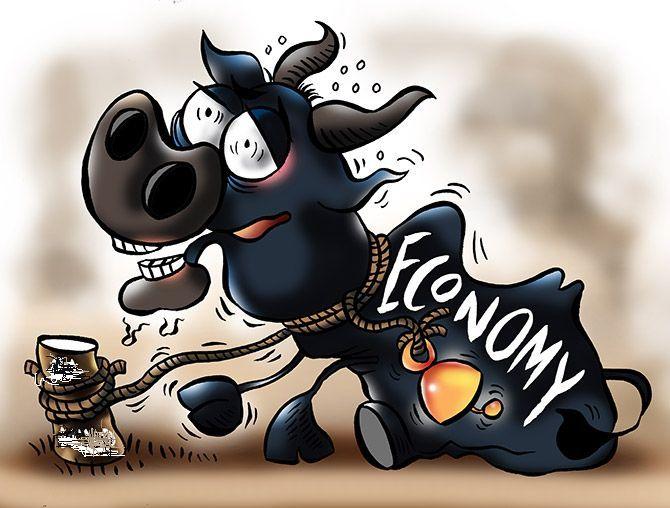 | « Back to article | Print this article |
The current slowdown has lasted for over 18 months and is the longest incident of sluggishness since 2006.
Illustration: Uttam Ghosh/Rediff.com

Analysts at Goldman Sachs see more pain in store for the Indian economy over the next few months despite the government’s stimulus unveiled last week.
In their recent co-authored report titled India’s Economic Slowdown, Andrew Tilton, their chief Asia-Pacific economist expects this slowdown to last at least a couple of quarters more.
“Weak global macroeconomic conditions, and a negative fiscal impulse are assumed to be a drag on economic activity.
"The risks to our outlook for economic activity for FY20 continue to be tilted to the downside, given the continued weakness in consumption indicators, and persistent confidence concerns emanating from NBFCs that the Goldman Sachs India Financials equity analysts have pointed out,” wrote Tilton in a co-authored report with Prachi Mishra and Sakshi Goenka.
The economic slowdown, they said, started in January 2018 and that problems at Infrastructure Leasing and Financial Services (IL&FS) was a result of the overall slowdown that had already been seeded in the third quarter of 2017-18 when the goods and services tax (GST) was introduced.
The current slowdown has lasted for over 18 months and is the longest incident of sluggishness since 2006, the report said.
Deep impact
Automobile sales - a commonly used benchmark to gauge the slowdown in the consumption patterns - Goldman Sachs believes - is just the tip of the iceberg, with other consumption indicators like air passenger traffic, tax collections, and sales of durable and non-durable consumer goods contributing twice the effect of autos.
“Automobiles contributed 17 per cent of the total slowdown, as against a 36 per cent contribution by other consumption-driven factors including bank agriculture credit, vehicle sales, rural wages, fuel consumption, farm exports, fertiliser sales, rail/air passenger traffic, household credit, and electronic exports,” they wrote.
While fertiliser sales and rail passenger traffic were the only indicators that started to fall towards the end of 2018, several variables, such as agriculture credit, rural wage growth and imports of electronic goods have, in fact, been on a descent since 2017, Goldman Sachs said.
“Some part of the slowdown could possibly also be associated with the implementation bottlenecks related to the introduction of goods and services tax (GST) in 2017.
"Effective credit crunch was consequent to the glitches in the GST refund system which tightened the working capital cycle in the industry, especially for the MSME sector. Year-on-year growth in bank credit started to slow only in late 2018, driven by credit to services; and appears to be a symptom of the slowdown, rather than a cause,” they noted.
A slowdown in the investment activity, tighter funding conditions, a decline in consumer confidence, high real interest rates, central government expenditure and monsoon were some of the factors that contributed to the overall sluggishness.
“The role of global factors is also very significant; slower growth in India’s trading partners acted as a major drag on economic activity during this period,” they said.
While the Reserve Bank of India (RBI) has cut repo rate by 110 basis points (bps) since February 2019, analysts at Goldman Sachs feel, the breadth and depth of policy easing have so far been much more limited than during previous occurrences of slower growth in India.
“Importantly, policymakers have exercised restraint in easing fiscal policies.
"Despite being issued in a period marked by a slowing economy and an election year, the FY20 budget did not envisage any additional stimulus through the reported fiscal deficit figures,” they wrote.